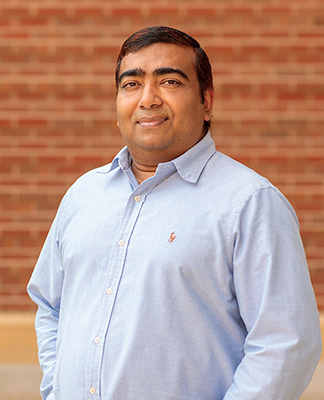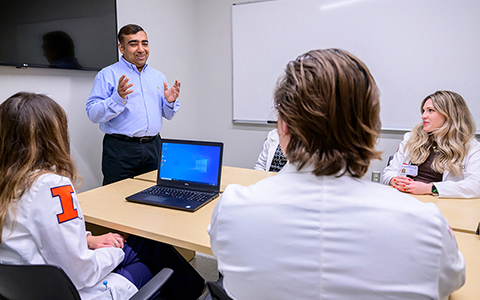Aug 28, 2023
What approaches can help improve the US healthcare system?

Ujjal Mukherjee is an associate professor of business administration at Gies College of Business at the University of Illinois Urbana-Champaign. An expert in technology adoption and mediation in healthcare, he has extensively studied resource management in the wake of the COVID-19 pandemic and how medical care can be optimized to provide the greatest possible benefit.
Q. There are many well-publicized problems with the US healthcare system, including rising costs and a shortage of doctors. It’s estimated that we have about one million doctors in a country with 330 million people. What’s the answer to improving care in the US, and how much of a factor does that shortage play?
A. A shortage of doctors and nurses is a major challenge facing not just the US, but many countries around the world. That shortage is interlinked with the increasing cost of healthcare. The Accountable Care Act (ACA) and other initiatives such as Medicare and Medicaid expansion is bringing a larger section of the population under the purview of managed care. These initiatives, which are positive developments, nevertheless, put pressure on the existing infrastructure. The COVID pandemic provided a negative shock to that capacity and set us even further behind. By 2030, for example, the US will face a shortage of one million nurses. That’s a huge number.
Addressing this shortage has to be a multipronged strategy. On one hand, we have to expand the capacity of nursing schools and medical schools, and then at the same time, we need to make their jobs as efficient as possible at the hospital level. Reallocation of nursing jobs and job-design at the hospital level has the potential to free-up some nursing capacity. At the same time, usage of travelling nurses and sharing of nursing resources across hospitals is going to be important.
The funding of social healthcare delivery also has to go hand in hand with all of this. How do you use the available taxpayer money so that it promotes the most efficient delivery of healthcare? You can supplement that funding with improved primary and preventative care, which in theory should reduce the demand for emergency care. Focusing on preventative care and value-added primary care is going to be important in the future in order to ease the demand for emergency care from the uninsured populations.

Q. In theory, increasing the number of primary care doctors would reduce the need for as many specialists or emergency room visits, which are the most expensive forms of care. Can’t we just flood the market with primary care doctors? How close is that to reality?
A. Yes, but we can’t go too far in that direction. There is an optimal point in allocating funding and resources between primary care and emergency care. Importantly, the marginal benefit of allocating more funds for primary care beyond this optimal point is very, very low. Increasing primary care should decrease the need for emergency care; however, there is a reducing marginal benefit of doing so beyond the optimal zone.
Almost a decade ago, California implemented a global payment system that basically set aside money from overall social funding to provide this value-added care (primary, preventative, and home care) with the idea that it should reduce the likelihood that a patient needs emergency care. There have been multiple reviews done on this program, and the results so far show that there was definitely a benefit to that. They’re still not at that optimal level, though. Our evaluation demonstrates that the current DSH [disproportionate share hospital] mechanism is not optimal in terms of social welfare; rather, a combination of emergency and preventative/primary care funding is necessary.
Q. So you’re saying it shouldn’t be all or nothing. There’s an optimal zone that we can reach. How close are we to finding that zone?
A. Our healthcare system in the US is so complex that understanding a theoretical zone and a realistic optimal zone is, in itself, a major challenge. What policymakers are trying to do is not just maximize the social benefit but also ensure fairness of allocation across different hospitals and communities. Sometimes the objectives of fairness and of social optimality are at odds with each other. To add another layer of complexity to this, the demand is also evolving over time. So while we are far from the optimal zone, we are trying to experiment and do what is best given the resources that we have.
Q. As a nation, we spend a ton of money per capita on healthcare, yet we don’t have near what is viewed as the crown jewel of healthcare systems in the world. Out of the roughly 1 million doctors in the US, only about a quarter of them are primary care physicians. Is there an estimate of the balance we need to make that a more efficient ratio?
A. It is a fair estimate to say that we will need at least another 100,000-150,000 primary care doctors, but the sheer number is not necessarily the most important factor. Technology is also going to play a huge role in the future of healthcare. There are telemedicine or kiosk systems which can augment or supplement existing capacity. That positive impact an extra 100,000 doctors can make will be greatly amplified if we can put the right technology in place. This technology can improve remote service and help them engage with even more patients in meaningful ways. Around 40-50% of the primary care capacity is utilized in providing healthcare for chronic conditions. Chronic conditions require long-term patient engagement with the healthcare system and proactive lifestyle management and health awareness from a diverse section of the population. Many of these populations are from remote and rural communities and also a large number are aging population with limited access to healthcare due to mobility and other issues. Therefore, the right combination of technology solutions that can supplement physical encounters of patients with the providers is going to be very important in the future. The emergence of AI and other advanced technologies such as surgical robots, remote sensing, telehealth, and imaging technologies are interesting developments that have the potential to redesign the healthcare delivery processes of the future.
